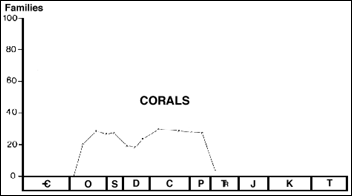
The archaeocyathans occupied the nutrient rich zone during the early Cambrian and there are no known occupants of the nutrient poor zone. The rest of the Cambrian showed no significant reef building activity during the rest of the Cambrian straight through to the Early Ordivician. The Tabulate and Rugose corals originated by calcification of some type of anemone like organism. The rugosoids (as well as stromatopoids, spicular sponges and bryozoans) appeared during the Silurian and Devonian in the form of great reef complexes. Tabulate corals and stromatopoids occupied the nutrient poor zone during this time. The rugosoids and tabulate corals were greatly affected by the Late Devonian Extinction. During the Carboniferous the reef niche was occupied until the Devonian. the niche was occupied by calcified sponges and bryozoans at this time. The tabulates and rugosoids hung on until late in the Paleozoic. Only to eventually succumb to the forces of extinction at the end of the Permian. The Lower Triassic rocks are void of fossil corals.
In the Middle triassic the Scleractarians appeared from some unknown origin. By the Late Triassic the Scleractarian had begun to contruct reef systems in the nutrient poor zones. The Scleratarians were major reef builders for the rest of Mesozoic and Cenozoic.
The evolutionary pattern amongst the corals have not yet been established since the differences in morphology have been a result of environmental alteration and do not window into the genetic evolution of the corals. For this reason micro evolutionary line lines of the corals are yet to be discovered. There has been no undisputed claims as of yet.